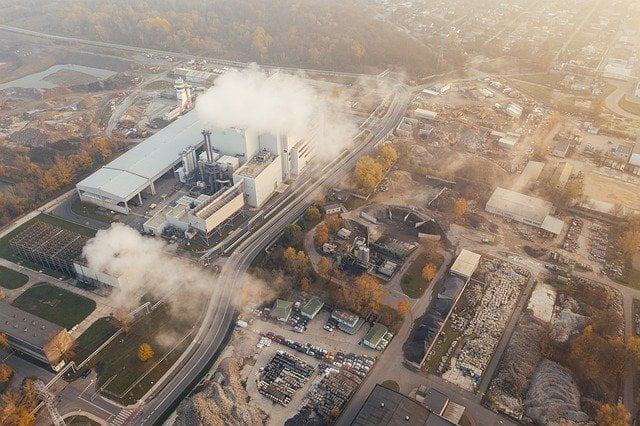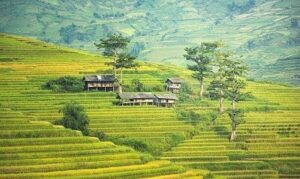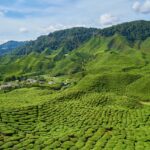
In this post, we will look at the ways in which humans interact with their environment, as well as the three types of human-environment interaction.
Table of Contents
What is Human-Environment Interaction?

What is Human-Environment Interaction? In Human-Environment Interaction, humans interact with the environment on a daily basis. The environment changes the lives of humans and at the same time, humans change the environment through their way of living.
(You can learn more about this interaction with the environment here. For a full list of all Human-Environment Interaction articles, visit Human-Environment Interaction Articles)
Human-Environment Interaction in Geography
Human-Environment Interaction is one of the 5 themes of Geography.
The relationship between the human social system and the natural world is at the core of human geography. The connection and exchange between them is called human-environmental interaction. This deals mainly with sustainability, pollution, and environmental issues.
You can look at this in more detail at Human-Environment Interaction in Geography.
Ways Humans Interact with the Environment
Let’s next look at the ways that humans interact with their environment. Some of the ways humans interact with their environment are through the use of natural resources, the building of roads and cities, pollution, deforestation, burning fossil fuels, and soil erosion.
We will explore a few of these in a little more detail next with some examples.
Human-Environment Interaction Examples
Here are some quick examples of human-environment interactions.
You can find the full list of examples at Human Environment Interaction Examples. Specifically, you can find the negative examples in Negative Human Environment Interaction Examples or the positive examples in Positive Human Environment Interaction Examples.
The Use of Natural Resources
Human beings use natural resources for everyday life. Humans need food and water from the environment in order to survive. Natural resources such as wood, metal, oil, diamonds, gold, and other resources are also used for human survival and advancement. Wood might be needed to build fires and cook food for example.
The Building and Expansion of Cities and Roads
The building of homes, cities, and businesses sometimes requires cutting down trees and altering the land and environment. This also creates spaces where animals and plants can no longer live.
Pollution

Cars and factories all create air pollution and toxic chemicals that are harmful to our health, the environment, and the ozone layer. One of the biggest causes of concern is carbon emissions.
The result of this can lead to global warming or climate change.
You can also learn about some of these effects in the Human activities that affect the environment PDF.
Three Types of Human-Environment Interaction
1. Humans Depend on the Environment
The environment changes the way humans live on an everyday basis. One way is the food that we eat. Since all of our food sources come from the environment, we as humans are dependent upon the environment to provide us with that food. For example, crops grow from the ground. We need the soil to be clean and fertile.
We also need rain for the crops to grow. Also, weather and climate can impact crops. Things such as cold weather, frost, heat, or drought can kill crops.
Also, animals in nature or bugs could eat crops or destroy them before they are harvested.
The environment might have an impact on humans and change the way we live through natural disasters. Hurricanes, volcanos, floods, drought, etc. All of these have an impact on human lives and are generally uncontrollable by humans.
2. Humans Adapt to the Environment
Next, we’ll look at how the environment changes what humans build and where they live. The actual geography and terrain of the land might dictate strongly if humans decide to build homes or other structures on the land.
The strongest example of this is, notice how not very many people build homes or structures in deserts, such as the Sahara, or in artic areas, such as Antarctica. That’s because the environment dictates that life would be extremely hard or impossible to live in these areas, so humans cannot build there.
In ancient times, in areas where resources were scarce, or the environmental conditions were harsh, humans would decide not to live in these areas. Also, if the land itself were too unstable to build on, this might cause humans to decide to live elsewhere. This could be land that is not flat enough or marshy areas where buildings would not be very stable.

But when humans do live in a certain environment, wherever they might happen to live, they adapt their lifestyle to the environment. People who live near water tend to fish and eat more fish or seafood as a way of life. People might change their dietary habits based on the environment and what food sources are available.
Also, humans can even adapt to the environment genetically and through traits that are passed down to their offspring. For example, those living in desert areas tend to be more suited for that type of climate, and those living in colder climates with less sun might adapt to those types of climates as well.
Another way humans adapt to the environment is the clothes that we wear. If the climate is cold, then we will need to wear heavier clothes and more clothes. If the climate is hot, then we will be wearing fewer clothes and cooler clothes like short sleeves and shorts.
Also, the type of materials made available by the environment might dictate what we wear and what our clothes are made out of. If cotton is more available and cheaper, then more clothes will be made out of that.
Native Americans were great at adapting to the environment and eating the foods around them. They would also wear skins from the animals in the environment in order to stay warm during the cold winter months.
3. Humans Modify and Change the Environment
Humans will modify the environment in order to survive or to get what they might desire. Typically these have ended up being negative impacts on the environment.
If environmental conditions are favorable, and land is buildable, then humans might decide to build homes or dwellings, or maybe even cities or strip malls and businesses. Sometimes there must be some kind of modification to the land in order to build the structures. For example, maybe cutting down trees or leveling out the ground in order to build buildings.
Another environmental factor that causes humans to build structures is water sources. Humans will build dams in order to change the flow of water for one reason or another. They might need to stop water from flowing to or flooding a particular area where people are living. The Hoover dam is one example of this.
Also, humans might need to have water go from one place to another. The Romans built aqueducts to carry water from one place to another. In modern times, we create pipes and plumbing systems that we place into the environment for some of the same reasons.
Also, humans might pave roads, highways, and railroads for transportation. All of this requires modifying the environment. Not only does this change the environment by the actual structures of the roads themselves running through the environment. But also, cars and vehicles that drive down these roads might scare away wildlife that would have naturally lived in the area, or might even hurt or kill animal wildlife that could be hit by cars.
Also, humans use the environment for natural resources and might change the environment to get these resources. One major example is the use of drilling. Humans drill for oil to be used as an energy source.
The problem is that this has a huge negative impact on the environment. Oil can be spilled into the ocean while drilling and cause of huge negative impact on the environment, destroying and contaminating sea life and seafood.
Also, the burning of oil to power vehicles and other machinery is one of the biggest pollutants that the earth faces. The act of drilling itself, causes methane gas to be released into the atmosphere, leading to climate change.
Summary
Some of the ways humans interact with their environment are through the use of natural resources, the building of roads and cities, pollution, deforestation, and the burning of fossil fuels.
The three types of human-environment interaction are:
- Humans depend on the environment
- Humans adapt to the environment
- Humans modify the environment
Video Resources
- Human Adaptation and Environmental Modification
- Climate, Agriculture, and the Challenges Ahead
- Native Americans Adapt to their Environment
- Human-Environment Interaction Adaptation vs Modification
Lance has been passionate about the plant-based diet and we have been following a whole food plant-based diet for over 5 years. We focus on health, natural healing, weight management, animal rights, and the health of the planet and environment by focusing on whole plant-based foods and sustainable practices.
Learn more at the About Me page and follow on social media at the links below.


